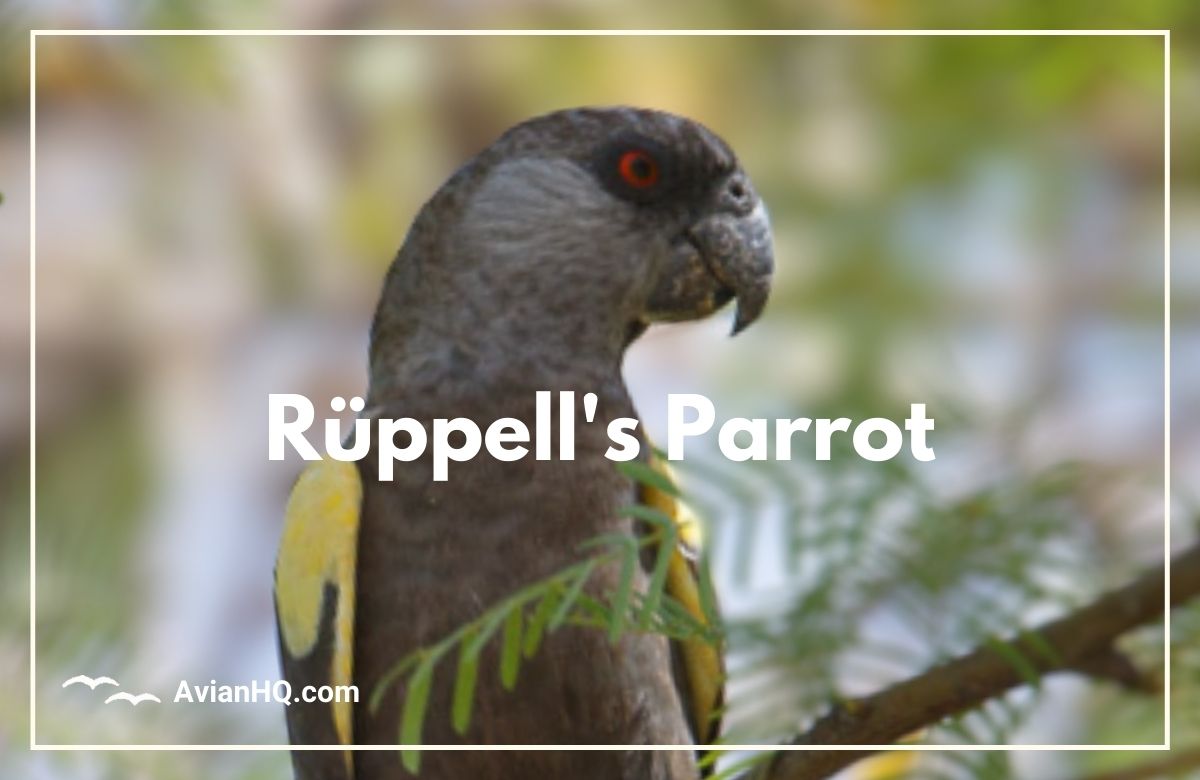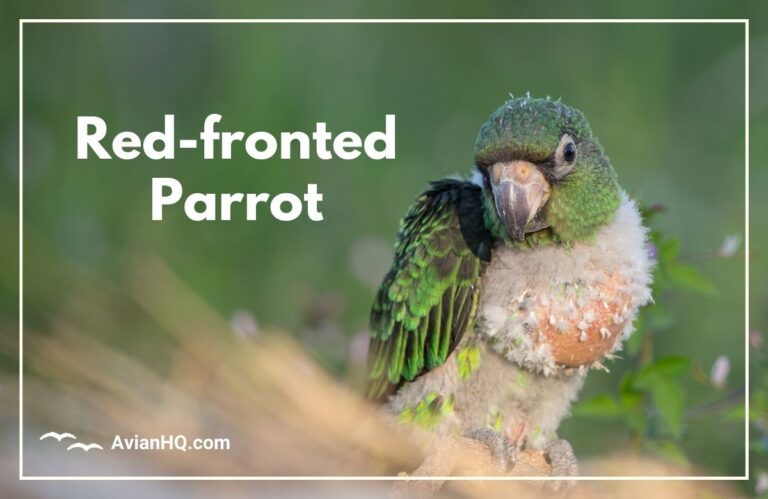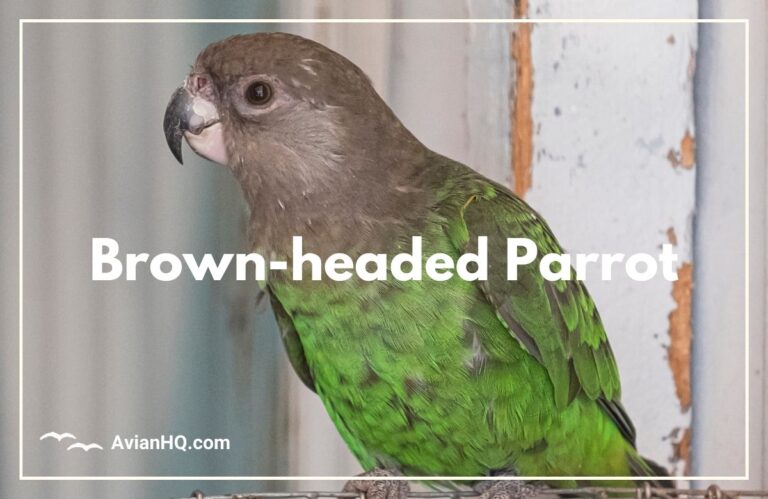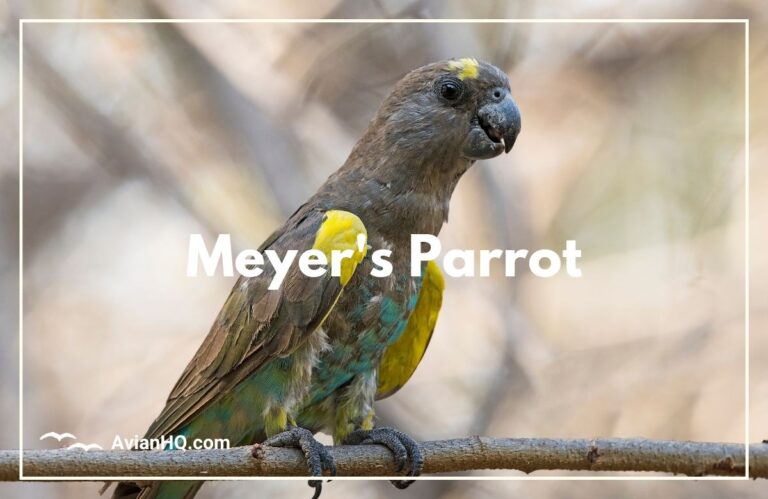Rüppell’s Parrot (Poicephalus rueppellii)
Have you ever seen a small, stocky parrot with striking red eyes and dark brown plumage accented by splashes of blue and yellow? If so, you may have spotted the Rüppell’s Parrot, a little-known African species named after the German explorer Eduard Rüppell. Measuring about 9-10 inches (22-25 cm) from head to tail, these birds inhabit dry forests and savannas in southwestern Africa.
Rüppell’s Parrots are shy and quiet but make endearing pets when bred in captivity. In the wild, their populations are decreasing across their native range in Namibia and Angola due to habitat destruction and trapping for the pet trade. Still, major declines have not occurred yet, so the species remains classified as Least Concern by the IUCN Red List.
You’ll learn all about these intriguing parrots in this comprehensive guide. We’ll explore their history and taxonomy, physical appearance, preferred habitats, diet and feeding behaviors, breeding habits, ecology and behavior, conservation status, significance in human culture, and more. You’ll also find tables and lists sprinkled throughout to call attention to important facts. By the end, you’ll be an expert on Poicephalus rueppellii!
First up is the history and classification of this little parrot. How, when, and by whom were they first discovered? Read on to uncover their origins.
History and Scientific Classification
The Rüppell’s Parrot’s namesake, explorer Eduard Rüppell, first discovered these birds during his travels in Africa in the 1830s. He collected a sample specimen which was then formally described by German zoologist Martin Lichtenstein in 1842, who gave it the scientific name Poicephalus rueppellii in Rüppell’s honor.
The genus name Poicephalus comes from the Greek words “poikilos,” meaning variegated or spotted, and “kephale,” meaning head. This refers to the colorful markings many parrots in this genus exhibit on their heads. The species name rueppellii commemorates Eduard Rüppell’s contributions to African zoology.
No subspecies of the Rüppell’s Parrot have been recognized. The birds occupy a restricted range in southwestern Africa spanning about 1,864 miles (3,000 km) across northern Namibia into southwestern Angola. Their range may have formerly extended farther north and east before habitat destruction.
Rüppell’s Parrots dwell exclusively in this arid region’s savannas and dry forests, typically not venturing above 4,100 feet (1,250 m) in elevation. They tend to stick close to water sources like rivers and streams that provide needed food and nesting sites within the riparian woodlands.
Now that you know a bit about when and how these parrots were first revealed to science, let’s examine their physical appearance and traits that help identify them.
Appearance and Physiology
The Rüppell’s Parrot is a stocky, medium-sized parrot reaching about 9-10 inches (22-25 cm) in total length and weighing between 4.3-5.5 ounces (121-156 grams). Their plumage has an overall dark brown coloration, with lighter scalloping on the nape and hindneck in some birds.
Their heads appear mostly greyish black, set off by round, bright red eyes in adults. The forehead, lores, and eyerings are also reddish in color. The stout grey bill is typical for parrots in the genus Poicephalus.
Both mature male and female Rüppell’s Parrots have yellow feathers on the bend of the wing as well as the upper thigh. However, adult females can be distinguished by vivid blue feathers on the lower back and rump. Males lose most blue coloration in these areas as they age, or it fades to a drab grey-blue.
Immature birds look much duller overall, with darker grey heads and brown irises instead of striking red eyes. Their yellow wing and leg markings may also be faint or entirely missing before their first molt. Juveniles take on mature plumage at around 14 months old.
Now you can identify these petite parrots by sight! Next, we’ll cover the dry African habitats they call home.
Native Habitat and Range
The Rüppell’s Parrot occupies a relatively small range in southwestern Africa consisting of central and northern Namibia and a portion of southwestern Angola. Its habitat centers around riparian forests and woodlands along seasonal rivers and streams within arid savanna and scrubland environments.
In Namibia, Rüppell’s Parrots are found across a north-south distribution spanning about 930 miles (1,500 km). Their range extends from the Kunene River south to the Windhoek area. The birds inhabit several major river valleys including the Swakop, Omaruru, Ugab, and Huab.
The Angolan range is more restricted, found mainly just inland from the Atlantic coast until about 125 miles (200 km) north of the city of Namibe. Their habitat preferences remain similar, concentrated along riparian forests and palm stands near rivers and streams.
Throughout it’s native range, these parrots are considered rare or uncommon residents. They typically occur at elevations below 4,100 feet (1,250 m), avoiding higher mountainous areas. But they may descend to lower valleys during colder winter months.
Next we’ll switch gears to feeding behaviors – what do these small parrots like to eat?
Diet and Feeding
In the wild, Rüppell’s Parrots are opportunistic, generalist feeders consuming a varied mix of seeds, fruits, flowers, leaves, buds, and some animal protein. Their diet changes in availability and abundance according to the rainy and dry seasons.
During the wetter months from January through April, the parrots regularly feed on flowers, fruits, and ripe seeds. Some favorite food plants include various fig and raisin trees, bushwillows, and mistletoes. They also eat softer fruits such as melons when available.
Rüppell’s Parrots supplement their diet with insect protein including moth and beetle larvae, termites, spiders, and possibly other small invertebrates. Bark may also be occasionally gnawed or stripped from certain trees.
In the dry season from May to December, leaves, pods, shoots, and unripe fruits become dietary staples as other foods grow scarce. The parrots display some seasonal movement tracking resources like the flowering and fruiting of the ana tree (Faidherbia albida). Their range contracts into riparian forests offering more reliable food and water.
Now that you understand their wild feeding habits, let’s move on to breeding and nesting behaviors.
Breeding and Nesting
Rüppell’s Parrots reach breeding maturity around 3 years of age. The breeding season lasts from January through June, coinciding with the rainy period which stimulates nesting activity. These parrots are monogamous, mating for life once a pair bond forms.
For nesting sites, they seek out tree cavities in living or dead trees, either natural hollows or old woodpecker holes. Favorite nest trees include ana trees (Faidherbia albida), camel thorn (Acacia erioloba), and Natal mahogany (Trichilia emetica). The female alone incubates the eggs and broods the young.
Clutch size averages around 3-5 glossy white eggs, though ranges from 2-8 have been observed. The female incubates the eggs for 24-30 days before they hatch. After hatching, both parents feed the altricial chicks a diet of seeds and fruit.
The chicks fledge at around 9-10 weeks old. However, the family may remain together for a period after fledging, allowing the juveniles to continue begging parents for food as they learn to forage on their own.
Now you know how these petite parrots raise their young. Up next, we’ll detail some of their behaviors and social ecology.
Behavior and Social Structure
In the wild, Rüppell’s Parrots live in small, loose flocks averaging about 12 birds but ranging from solitary pairs up to groups of 20. Larger aggregations may form where food sources are abundant.
These social flocks roost communally in trees, often returning to traditional sites. Roosts are typically situated along or near rivers with ample food and water. Flocks break apart into smaller foraging groups with the morning light.
Rüppell’s Parrots fly swiftly and directly with rapid, stiff wing beats. Their flight profile shows long tails and trailing edge fringes to the wings. In flight, their striking red eyes and yellow wing patches are noticeable.
Vocalizations are relatively muted compared to other African parrots. These birds make short, whistled contact calls between pairs or flock members described as monotonous and sharp. Alarm calls are louder shrieks that increase in pitch.
Beyond bonding with flock mates, Rüppell’s Parrots form close social pairs that may persist for life. Partners engage in mutual preening and stick close together when foraging and roosting. Next, we’ll take a look at this species’ threatened conservation status.
Conservation Status
The Rüppell’s Parrot is evaluated as Least Concern on the IUCN Red List of Threatened Species. However, it’s populations are suspected to be decreasing across it’s limited native range due to ongoing habitat degradation and trapping pressures.
In Namibia, habitat loss from riparian forest clearing and the conversion of woodlands for agriculture and livestock grazing threatens the availability of nest sites and food resources. Capture for the wild bird trade also affects local numbers.
An estimated several hundred Rüppell’s Parrots are trapped and exported from Namibia to South Africa annually, though a high percentage perish in transit. Trapping mainly targets fledglings still in the nest or recently independent juveniles.
Across their restricted range spanning parts of Angola and Namibia, current population sizes are uncertain but likely number under 30,000 mature individuals in Namibia based on survey data. Angolan populations are nearly unstudied.
Despite declining populations, Rüppell’s Parrots maintain a large enough range and numbers to be ranked as Least Concern. However, increased protections and active management may be needed to prevent future declines warranting a Threatened category listing.
Up next, we’ll talk about some cultural and aviculture significance of these birds.
Here is a draft of the next section on the relationship to humans and captivity of the Rüppell’s Parrot:
Relationship to Humans
The Rüppell’s Parrot has some significance in aviculture due to it’s petite size, quiet nature, and affectionate personality when hand-raised. However, limited export availability means they are not common aviary birds.
Captive breeding success has increased in recent years, focused mainly in South Africa. Still, Rüppell’s Parrots are considered somewhat sensitive birds that can become neurotic, destructive, or aggressive without proper training, socialization, and environmental enrichment.
When hand-fed from a young age, these parrots bond strongly to their owners. They may exhibit territorial or jealous behaviors, becoming nippy with perceived competition for their human companion’s attention and affection.
With an average lifespan over 30 years, well-socialized Rüppell’s Parrots can make endearing lifelong pets. But their specialized needs for mental stimulation and sensitive nature limits the number of suitable homes available.
In the wild, Rüppell’s Parrots play an important role as seed dispersers for various trees and forest ecosystems across their dry woodland habitat range. Next up, we’ll summarize everything you’ve learned about this little African parrot.
Conclusion
The Rüppell’s Parrot is a charming African endemic that remains mysterious in many aspects of it’s natural history. As we’ve explored, these petite parrots inhabit savannas and riparian woodlands in arid southwest Africa, where the availability of nest sites and food influences their seasonal movements.
They form loyal bonds with flock mates and life partners, raising just a few chicks each year in tree cavity nests. Though Rüppell’s Parrots are quiet and unassuming in nature, their specialized behaviors and habitat needs make them vulnerable to disturbances.
Habitat loss and trapping pressures have caused suspected population declines across their range in Namibia and Angola. However, estimated totals likely still number in the tens of thousands, allowing the species to persist for now as Least Concern.
In captivity, hand-raised Rüppell’s Parrots can be affectionate companions with their owners. But their sensitive psychology demands environments rich in mental stimulation and gentle handling to thrive. Continued research is critical to track wild populations and better understand how to safeguard the species’ remaining dry forest ecosystems.
Now you’re an expert on these remarkable African parrots! By protecting their natural habitats and judiciously managing captive-bred birds, we can ensure Rüppell’s Parrots prosper for generations to come.







